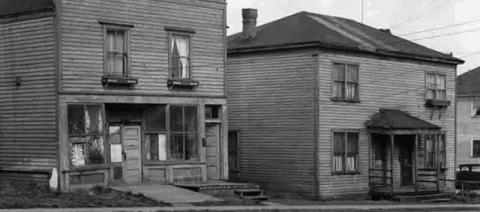
The site of Yesler Terrace was prominent from Seattle’s beginnings as a city. At its western shoreline, Yesler Way was first the site of Yesler’s mill—the first mill in Seattle—and the city’s first center of development. The original King County Courthouse was located on this part of First Hill, situated between 7th and 8th Avenues and Terrace and Alder Streets. The Yesler Terrace property extended to 12thAvenue, to an area of Jewish settlement in the late 19th century. Its southernmost edge was part of what was known then as “Japantown,” later the International District. Also known as “Profanity Hill,” because of the steepness of street grades, the surrounding area was developed up through the first decade of the 20th century with dense, wood-frame multi-family townhouses, apartment hotels, and boarding houses.
By the 1930s much of the area was considered blighted. There were many benefits to the site selected for Yesler Terrace: The original development would replace deteriorated housing stock. Furthermore, it offered residents close proximity to the nearby County Hospital and several public schools, and to downtown, which was easily accessible by foot or streetcar.
The original site also offered an enviable view, which included Mt. Rainier to the south and Elliot Bay and the Olympic Mountains to the west. This view, among other things, was an important factor in offering the eventual residents of Yesler Terrace pride of place.
Creation of Seattle Housing Authority
Creation of a public housing authority in the Seattle was initiated when a young Seattle attorney, Jesse Epstein, approached Mayor Arthur Langlie in 1937 for assistance in realizing local housing reforms.
Epstein explained to Langlie how the new federal legislation worked and how Seattle could obtain federal funds for slum clearance projects and new low-income housing. Epstein formed a committee to write legislation to enable the city to create a housing authority and thus receive government assistance. Epstein also approached the members of City Council with his proposal and secured support from three of its five members. A city ordinance was passed in 1937 creating a Local Advisory Housing Commission. Epstein was made the committee chairman, and $25,000 was granted to it to begin its work.
The words of the ordinance stated the goals of the new committee: “Thousands are unemployed in Seattle, among them hundreds of members of the building trades who will share directly in the benefits derived by the whole community from a well-conceived local municipal low-cost housing program.”
In 1938, the City Council declared intent to establish a housing authority eligible for federal assistance. Epstein’s comprehensive knowledge of enabling legislation and new federal funding programs qualified him to draft the bill allowing a housing authority in every city and county in the state. The legislation was passed in 1939, making Washington the 34th state to pass such laws. Meanwhile, in March of that year, the Seattle Housing Authority was established and Epstein was named director. Other members of the Seattle Housing Authority Board included prominent citizens George W. Coplen, Kenneth J. Morford, Charles W. Doyle, and Mrs. Frank D. Henderson.
During this process, Epstein did his best to persuade the public of the importance of public housing. In a July 1938 article, he outlined the principles and purposes of the U.S. Housing Authority: “to provide financial assistance to the States and political subdivisions thereof for the elimination of unsafe and unsanitary housing conditions, for the eradication of slums, for the provisions of decent, safe, and sanitary dwellings for families of low-income, and for the reduction of unemployment and the stimulation of business activity.”
He highlighted the fact that many other states were ahead of Washington in creating local housing authorities and using federal aid for low-income housing projects, and also emphasized the jobs that construction of these projects would provide.
Shortly after its organization, SHA received $3,000,000 from the federal government for low-income public housing and slum clearance.
